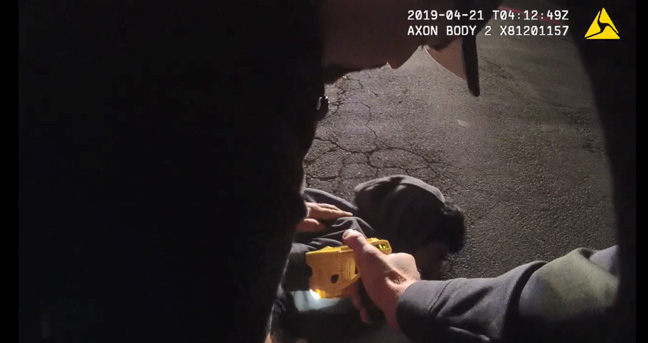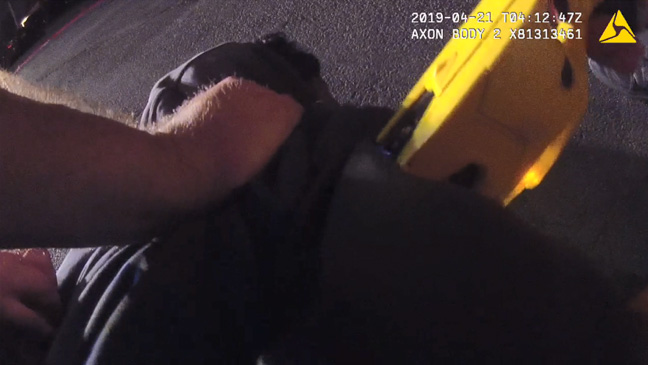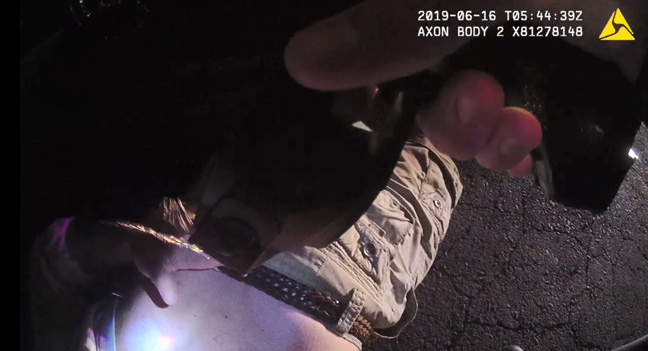Police Brutality Involving the Use of Tasers

“TASER” is the brand name of an electroshock weapon manufactured and sold by Axon, formerly TASER International. The word “Taser” has become so popular that it is generally used to describe any hand-held electric-discharging muscle immobilizer. Tasers are sometimes referred to more descriptively as conducted energy devices, conducted energy weapons, electronic control devices or electronic control weapons. For simplicity, we will refer to the weapon a Taser, with no association to any particular brand name or company intended.
The use of the Taser as a less lethal alternative to firearms has increased greatly in the past couple decades. According to a study by the National Institute of Justice, more than 15,000 military and law enforcement agencies use some form of the weapon. Supporters of the Taser claim that the device helps protect police officers who may otherwise be forced to engage in hand-to-hand combat. They also argue that the weapon may be used as a less deadly alternative to a firearm. As a result, advocates of the Taser claim that Tasers save the lives of both police officers and criminal suspects.
However, as will be discussed below, Tasers can cause serious injury or death, especially to individuals with certain underlying conditions or when the device is discharged repeatedly. Sometimes, law enforcement officers abuse this weapon and use it to punish individuals. Other times, law enforcement can use this force option as a short cut to gain compliance when it is not needed. For example, when simple communication and de-escalation techniques could have resolved the conflict.
How Does a Taser Work?
A Taser is a hand-held weapon that shoots barbed dart-like electrodes (often referred to as darts) that are intended to incapacitate a person by paralyzing his or her nervous system. Each Taser cartridge is single-use and contains a nitrogen charge and electrodes, which are propelled by the charge. The darts are attached to the main component with thin copper wires. The darts are designed with pointed tips and are barbed. This helps the darts to pierce the skin and clothing and to remain affixed to the individual. Depending on the Taser model, the darts can travel up to 180 feet per second, with a maximum range of 35 feet. However, practically speaking, a Taser’s effectiveness diminishes greatly when fired from farther away than 15–25 feet from the target.
When a police officer fires the dart-like electrodes at a target from a distance, this is called using a Taser in “dart-mode.” However, many Tasers carried by law enforcement also have what is referred to as “drive-stun” capability. In drive-stun mode, no darts are fired. Instead, the Taser is held directly against the individual. This can be done after a cartridge has been deployed in dart mode or without a cartridge in place. The Taser in drive stun mode does not paralyze a target’s nervous system. Instead, it is intended to effect compliance through pain.
Are There Different Types of Tasers?
Axon has three Taser models available for use by police officers. The X2 model is a two-shot weapon, which eliminates the need to reload in case of a missed shot or a dart that does not attach to the targeted individual. The X2 also comes equipped with dual lasers for accuracy and an audible warning arc. The purpose of the warning arc is to increase voluntary surrender before the need to discharge the Taser.
In contrast, the X26 and X26P model is only a single-shot smart weapon. It is the smallest and most compact of Axon’s Tasers. Finally, there is the TASER 7, which Axon describes as “The most effective TASER weapon ever.” The darts fly faster and straighter with almost double the kinetic energy, allowing for better connection. The TASER 7 is also equipped with a back-up shot and allows for simultaneous two-cartridge reload.
Notably, certain features of Axon’s Taser models can help hold law enforcement accountable when they misuse these potentially deadly weapons. For example, the X26P records when the weapon was used and other performance metrics, including the electrical output at the time of use. Similarly, the X2 uploads data logs automatically when the battery is removed and docked. The TASER 7 also uploads use logs simply by docking the weapon.
In addition to creating use logs, these devices can also help visually capture incidents of police brutality. Recently, Axon expanded its business into the areas of software and body cameras. All three Taser models are “Axon Signal compatible.” This means that when a Taser is armed, nearby Axon body cameras automatically begin recording. This sort of evidence can be invaluable to victims of police brutality when there is a dispute as to what occurred and whether the use of force was needed or appropriate.
Can a Taser Seriously Injure or Kill Someone?
Yes. The ability to cause serious injury or death has been a major criticism of Taser use in recent years. According to a study published by the American Heart Association’s journal, Circulation, Tasers can cause abnormal heartbeats, heart attacks and death. Reuters recently reported at least 1,081 deaths in the United States following the use of Tasers. Certain categories of individuals may be particularly vulnerable to the risk of serious injury or death. Many of the persons most at risk fall into one or more of the following groups:
- Children
- Pregnant women
- Elderly persons
- Extremely thin individuals
- Individuals with heart disease
- Individuals with pacemakers
- Individuals with a history of seizures
- Individuals who are high on illegal drugs
- Individuals under the influence of certain medications, including legal prescriptions
People who have been tased repeatedly or for extended periods are also at greater risk of harm. According to the Department of Justice, police officers should refrain from the continuous activation of Tasers for longer than 15 seconds. Typically, the Taser will cycle for one five second deployment upon each trigger pull. As such, the guidelines set forth that no more than three successive trigger pulls be used. Also, police officers are taught to reevaluate the situation and need for force after each trigger pull and before the next. Finally, police officers are taught not to deploy the Taser when an individual is unable to comply with a command given and for that reason alone.
There are also secondary or indirect dangers associated with Tasers that people should be aware of. These are risks of harm that result from a person’s surroundings when tased as opposed to the harm caused directly by the electricity of the Taser. Circumstances that could present a significant indirect risk of harm include the following:
- A person in an elevated position when tased
- A person running on a hard surface when tased
- A person tased when operating heavy machinery or a vehicle
- A person tased near flammable or explosive material
The secondary risk to an individual may be more significant than the risk of harm from the Taser itself. Not everyone who is tased will fall into one of the vulnerable categories discussed above, such as persons with pacemakers. On the other hand, anyone tased while running up or down stairs or at a gas station faces a significantly greater risk of suffering a serious injury or death.
When Can the Police Lawfully Use a Taser?
As discussed on our main Police Brutality page, when cops use force in making an arrest, they are held to a standard of objective reasonableness. The use of a Taser is no exception. A police officer’s use of a Taser must be reasonable under the circumstances. If it is not, the cop violates the individual’s Fourth Amendment right to be free from an unreasonable seizure. This constitutes what is commonly referred to as excessive force.
As with other determinations of objective reasonableness, the intrusion on the victim’s Fourth Amendment interests must be weighed against the interests of the government in the use of force. The first step is to assess the intrusion by considering the amount and type of force used by the officer. Importantly, the Ninth Circuit has recognized that Tasers “used in dart-mode constitute an intermediate, significant level of force that must be justified by the government interest involved.”
Next, the court will look to the facts and circumstances of the case and consider the governmental interests in the use of force. At a minimum, the following factors (commonly referred to as the Graham factors) will be considered:
- The severity of the crime
- The threat to the safety of others, including the police officers
- Whether the person was actively resisting or attempting to evade arrest
Other considerations, depending on the facts of the case, may include:
- The time the police officer had to deliberate before determining to use force
- The number of officers at the scene
- Whether less intrusive means were available to the officer
- Whether the suspect was emotionally disturbed or mentally ill
- The number of innocent bystanders in the area
- Whether appropriate warnings were given
- Whether back-up was on the way
- Whether the case involved a domestic disturbance
The intrusion on the suspect’s Fourth Amendment rights is then balanced against the importance of the government’s interests that it is supposedly justified for that particular use of force. Again, the standard is one of objective reasonableness. The subjective intent of the police officer does not matter. The Ninth Circuit has described the reasonableness test as follows:
The `reasonableness’ of a particular use of force must be judged from the perspective of a reasonable officer on the scene, rather than with the 20/20 vision of hindsight. In addition, [t]he calculus of reasonableness must embody allowance for the fact that police officers are often forced to make split-second judgments — in circumstances that are tense, uncertain, and rapidly evolving — about the amount of force that is necessary in a particular situation.
Taser Case Handled by Piccuta Law Group
The police brutality attorneys at Piccuta Law Group recently argued a case involving the use of a Taser in dart-mode. The parties disputed whether the use of a Taser was excessive force. The court undertook the balancing test and first concluded that the police officer’s use of a Taser in dart-mode was an intermediate, significant intrusion on our client’s Fourth Amendment rights.
Next, the court assessed the government’s interests in using the Taser. The court began by considering the severity of the crime or crimes of which our client was suspected. At most, our client had committed a minor traffic infraction and a non-violent misdemeanor for disobeying a police officer’s instructions to exit his vehicle.
As to any threat of safety to others, the police officer claimed our client’s actions were threatening because our client ignored an instruction to exit the vehicle, because our client caused the cop’s Taser to be caught in the window and because our client lunged toward the passenger seat. The court decided that noncompliance with an order, alone, does not necessarily present a threat to the safety of the officer. Further, no part of the officer’s body was caught in the window when our client attempted to roll it up. It was only the Taser that was caught. As to the alleged lunge toward the passenger seat, we presented evidence showing that our client simply dove to try to avoid the Taser after he saw that it had been activated. The court concluded that our client did not present a safety threat that would justify the use of a Taser.
Finally, we offered evidence showing that the only resistance of our client before he was tased was that he did not exit the vehicle as ordered and expressed disagreement that he should have to do so. Importantly, the court noted the difference between passive and active resistance and determined that our client’s resistance was minimal or passive. In sum, the court held that the evidence presented was enough to establish that the officer was guilty of police brutality for the use of his Taser.
Useful Resources
The following link is to guidelines regarding the use of Tasers from the United States Department of Justice. It sets forth standards regarding the appropriate use of Tasers and provides data regarding the same. It was published in 2011 and no subsequent versions have been published since that time. As such, it is still relied on as authoritative as to issues regarding the use of Tasers by law enforcement.
2011 United States Department of Justice Guidelines on Taser Use by Law Enforcement.
Contact the California Police Brutality Attorneys at Piccuta Law Group
While Tasers may be a safe alternative to guns, Tasers can cause serious bodily injury or even death. Police officers who are not properly trained sometimes use Tasers when that level of force is not needed. Officers may also use Tasers against vulnerable people or in dangerous circumstances. The results can be devastating. The police brutality lawyers at Piccuta Law Group have significant experience and a record of success handling police brutality cases, including when a Taser is used. Contact us at (831) 920-3111 for a free consultation or send us an email through the form on this page. A skilled and experienced civil rights attorney is available now to discuss your case and help determine your right to a recovery.
About the author: The content on this page was written by California civil rights lawyer and Monterey personal injury attorney Charles “Tony” Piccuta. Piccuta graduated with honors from Indiana University-Maurer School of Law in Bloomington, Indiana (Previously Top 35 US News & World Report). Piccuta took and passed the State bars of Arizona, California, Illinois and Nevada (all on the first try). He actively practices throughout California and Arizona. He is a winning trial attorney that regularly handles serious personal injury cases and civil rights lawsuits. He has obtained six and seven figure verdicts in both state and federal court. He has been recognized by Super Lawyers for six years straight. He is AV Rated by Martindale Hubble. He is a member of the Consumer Attorneys of California, American Association for Justice, National Police Accountability Project, Arizona Association of Justice, Maricopa County Bar Association and Scottsdale Bar Association, among other organizations.
Disclaimer: The information on this web site is attorney advertising and is for informational purposes only. It does not constitute legal advice. Reading and relying upon the content on this page does not create an attorney-client relationship. If you are seeking legal advice, you should contact our law firm for a free consultation and to discuss your specific case and issues.



